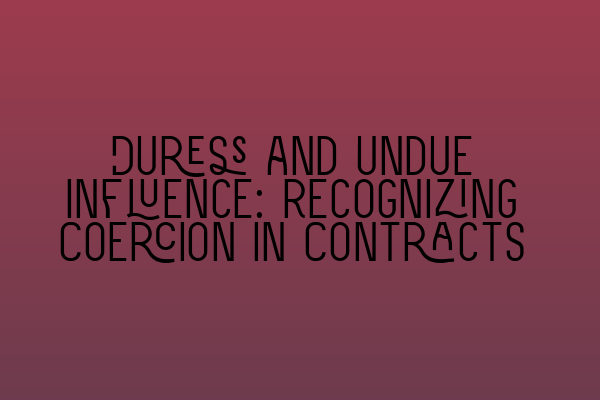Duress and Undue Influence: Recognizing Coercion in Contracts
Contracts form the cornerstone of legal agreements, binding parties to their obligations and setting forth the terms and conditions of their relationship. However, not all contracts are created equal, and there are instances where one party may feel coerced or unduly influenced during the formation of a contract. In such cases, the contract may be deemed invalid or unenforceable due to duress or undue influence.
It is crucial for both solicitors and individuals entering into contracts to understand the concepts of duress and undue influence, as well as how to recognize and address instances of coercion. In this article, we will explore these topics in detail, shedding light on the legal standards and considerations surrounding duress and undue influence in contract law.
What is Duress?
Duress, in the context of contract law, refers to the situation where one party coerces another party into entering into a contract against their free will, by employing threats, violence, or other forms of undue pressure. The party under duress is essentially deprived of their freedom of choice and forced to agree to the terms of the contract under duress.
It is important to note that duress can be either physical or economic in nature. Physical duress involves direct threats or harm, while economic duress involves financial threats or consequences that significantly impact the individual’s decision-making ability.
When assessing whether a contract has been entered into under duress, the courts will consider various factors, such as the nature of the threats, the vulnerability of the party being coerced, and the presence of alternative options. If the court determines that duress was present, the contract may be voidable at the option of the coerced party.
Recognizing Duress in Contracts
There are several key indicators that may suggest the presence of duress in a contract. These indicators include:
- Physical intimidation: Threats or acts of physical harm aimed at forcing compliance.
- Undue influence: Manipulation or exploitation of a position of power or trust to coerce the other party.
- Unfair pressure: Demands that are excessive, unreasonable, or unforeseeable.
- Lack of alternative options: The coerced party may have no other reasonable choice but to agree to the contract.
- Unequal bargaining power: Significant disparity in the power, knowledge, or resources between the parties.
If any of these indicators are present, it is crucial to thoroughly investigate the circumstances surrounding the contract’s formation to determine if duress played a role. Seeking legal advice from a qualified solicitor is highly recommended to properly assess the situation and protect the rights of the coerced party.
Understanding Undue Influence
Undue influence, unlike duress, does not involve direct threats or coercion. Instead, it occurs when one party exerts control and influence over another party and improperly exploits this influence to their advantage. The influenced party’s free will is undermined, and their decisions are guided by the dominating party’s wishes.
Undue influence can arise in situations where there is a relationship of trust and confidence between the parties involved, such as between family members, close friends, or business partners. It is important to note that undue influence can be either actual or presumed, depending on the circumstances.
In contract law, undue influence renders a contract voidable, meaning it can be set aside by the influenced party if they can prove that they did not exercise free will and were unduly influenced by the dominating party.
Identifying Undue Influence in Contracts
Recognizing undue influence requires a careful examination of the circumstances surrounding the contract’s formation. Some common signs of undue influence include:
- Isolation: The influenced party may be kept secluded from friends, family, or trusted advisors, making it easier for the dominating party to exert control.
- Manipulative behavior: The dominating party may use emotional manipulation, deceit, or threats to influence the decisions of the other party.
- Unfair advantages: The dominating party may seek to gain unusual or excessive benefits from the contract arrangement.
- Power imbalance: There may be an evident imbalance in power between the parties involved, including differences in age, mental capacity, or financial resources.
If these indicators are present, it is crucial to seek legal assistance to investigate further and determine if undue influence was a factor in the formation of the contract.
In conclusion, recognizing duress and undue influence in contracts is essential to protect the rights and interests of individuals entering into legal agreements. Understanding the signs and implications of duress and undue influence can help solicitors, as well as individuals, identify potential instances of coercion and take appropriate action.
If you believe you have been coerced or unduly influenced in a contract, it is advisable to seek prompt legal advice. At SQE Contract Law, our team of experienced solicitors is dedicated to providing expert assistance in contract law matters. Contact us today to learn more about your rights and options.
Related Articles:
- Mentorship for Aspiring Solicitors: Nurturing Talent in the Legal Field
- Legal Challenges and Pitfalls: Navigating the Complexities of the Legal System
- Mastering the Solicitor’s Path: Prepare for the Journey Ahead
- The Benefits of Becoming a Solicitor: A Rewarding Career
- Success on a Silver Platter: Achieving Work-Life Balance in the Legal Field
